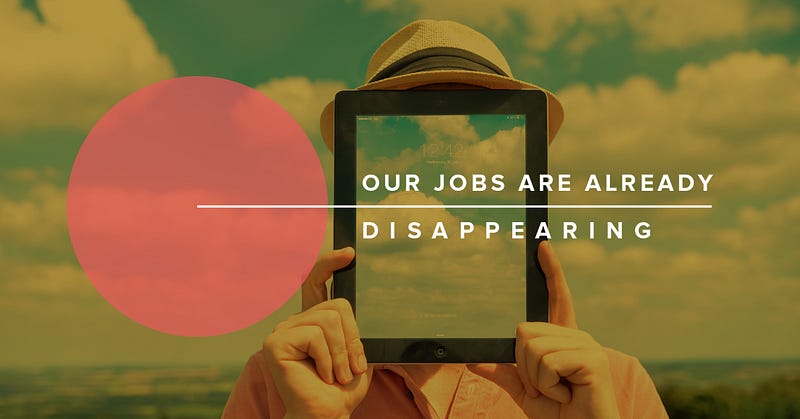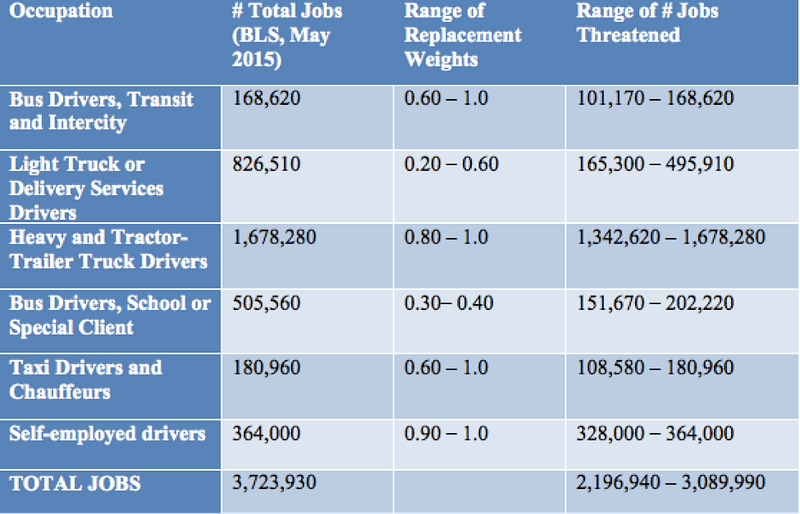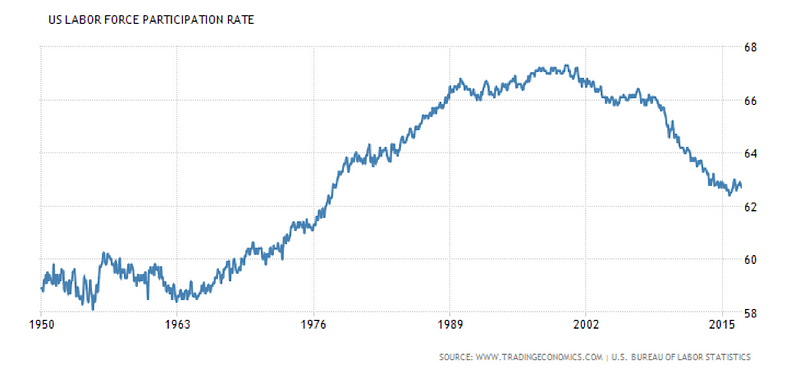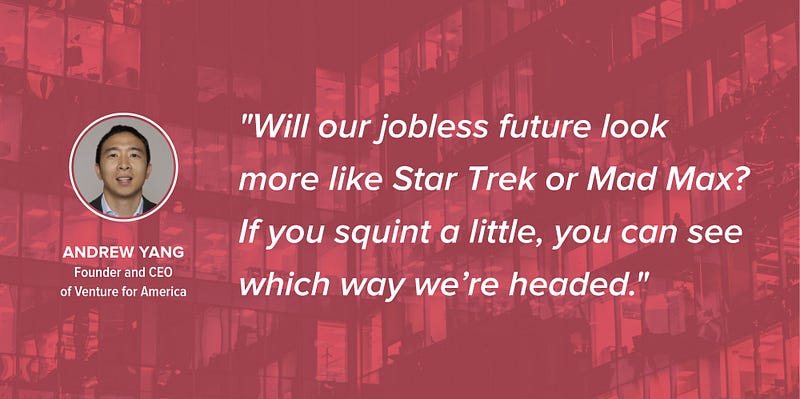Silicon Valley Is Right — Our Jobs Are Already Disappearing
Posted by federico in federico on Mar 20, 2017 2:40:00 PM
Silicon Valley Is Right — Our Jobs Are Already Disappearing
Stephen Hawking says that “we are at the most dangerous moment in the development of humanity” and that the “rise of artificial intelligence is likely to extend job destruction deep into the middle classes, with only the most caring, creative or supervisory roles remaining.”
Sam Hinkie, the smartest man in sports and a Stanford grad, asks, “How are you preparing your kids for a life with 60% unemployment?”
Sam Altman, the head of Y Combinator, is so convinced that we’re going to need to figure out new ways of providing people with a means to live that he’s giving ~$20k each to 1,000 people in Oakland for a year just to see what they do with their new jobless income.
Literally the smartest people in the world think an unprecedented wave of job destruction is coming with the development of artificial intelligence, robotics, software and automation. My friends in Silicon Valley have read the Second Machine Age and Rise of the Robots and they see a wave coming.
The White House published a report last month that reinforced this view. Some of the headline stats:
- 83% of the jobs where people make less than $20 per hour will be subject to automation or replacement.
- Between 9% and 47% of jobs are in danger of being made irrelevant due to technological change, with the worst threats falling among the less educated.
- Between 2.2 and 3.1 million car, bus and truck driving jobs in the U.S. will be eliminated by the advent of self-driving vehicles.
Source: Executive Office of the President of the United States; Artificial Intelligence, Automation, and the Economy; December 2016
Read that last sentence again: we’re confident that between 2 and 3 million Americans who drive vehicles for a living will lose their jobs in the next fifteen years. Self-driving cars are the most obvious job-destroying technology, but there are similar innovations ahead that will dislocate cashiers, fast food workers, customer service representatives, groundskeepers and many many others in a few short years. How many of these people will be readily employable elsewhere?
Okay, you’re thinking. But isn’t this all still in the somewhat distant future, since unemployment is only 4.6% according to the headlines? Actually, automation has already eliminated about 4 million manufacturing jobs in the U.S. since 2000. And instead of finding new jobs, a lot of those people left the workforce and didn’t come back. The U.S. labor force plummeted by about 10 million during the same period, down to levels not seen in decades. The labor participation rate is now at only 62.7%, a rate right below El Salvador and right above the Ukraine:
Each 1 percent decline in the labor participation rate equates to approximately 2.5 million Americans dropping out. The number of working-age Americans who aren’t in the workforce has surged to a record 95 million, up almost 500,000 in the last month alone, with many of these being factory workers.
Yes, there are 95 million working-age Americans no longer in the workforce. The Great Displacement is already here and is set to accelerate.
High rates of unemployment are linked to higher rates of substance abuse, domestic violence, child abuse, depression and just about every other social ill. Despair, basically. Note the recent spike in drug and opioid overdoses in the U.S. If you care about communities and our way of life, you care about people having jobs. This is the most pressing economic and social issue of our time.
Our economy is evolving in ways that will make it more and more difficult for people with lower levels of education to find jobs and support themselves.
It’s a boiling pot getting hotter one degree at a time. And we’re the frog.
I run an organization, Venture for America, with the mission of helping to create 100,000 U.S. jobs by 2025. We do this by helping growth companies access talent and training the next generation of entrepreneurs. We are taking some of the strongest young people in the country and saying, “Hey, use your talents to do some good and build businesses in Detroit, Birmingham, Baltimore, New Orleans, Cleveland, Philadelphia or some other U.S. city that could use a boost.” We’ve had some incredible success stories with people building multi-million dollar businesses that have hired dozens or even hundreds of people, including some low-skilled manufacturing workers.
We’ve trained over 500 aspiring entrepreneurs to work in eighteen cities around the U.S., and are now recruiting executives from Silicon Valleycompanies who want to help. We saw the decline in American entrepreneurship in markets around the country and resolved to do something about it.
I’m proud of everything that we do. But I feel increasingly like we’re working on islands of relative prosperity that are shrinking beneath our feet.
Every business will hire the very best people it can find — particularly startups. When our entrepreneurs start companies and expand, they generally aren’t hiring the down-on-his-or-her-luck-marginal-worker-in-need-of-a-break. They’re hiring the strongest contributors with the right mix of qualities to help an early-stage company succeed. The majority of the startup jobs that we’re helping to create essentially require a college degree. That excludes 68 percent of the population right there. And some of these companies are lifting further inefficiencies out of the system — reducing jobs in other places even while hiring its own new workers.
I’m reminded of a scene in The Hard Things about Hard Things, when Ben Horowitz meets with his two lieutenants. He says to one of them, “You’re going to do everything in your power to make this deal work.” Then he turns to the other and says, “Even if he does everything right, it’s probably not going to work. Your job is to fix it.”
That’s where we’re at. Unprecedented things are happening in real-time and starting to wreak havoc on lives and communities around the country, particularly on those least able to adapt and adjust.
We should do all we can to reduce the worst effects of the Great Displacement — it should be the driving priority of government and non-profits for the foreseeable future. We should invest in education, job training, apprenticeships, relocation, entrepreneurship, matching people to opportunities, tax incentives to hire — anything to help make hiring and retaining workers appealing.
And then we should assume that, for millions of people, it’s not going to work. Uber is going to get rid of its drivers as soon as it can. Its job is not to hire lots of people — its job is to move customers around as efficiently as possible.
One programmer, Labib Rahman, said to me recently that “any responsible technologist has to be for providing people a universal basic income to make ends meet.” He knows what’s coming.
Before long, we’re going to have to rethink the relationship between work and being able to feed yourself. And then figure out how to convey the psychic and social benefits of work in other ways.
It’s one reason why what Sam Altman is doing in Oakland is so fascinating and important. He’s basically piloting what the government should be doing so there will be relevant data when the need is too pressing to ignore. Many of my friends think that people will just chill out if you give them free money. I tend to think they’ll make the most of it and try to better themselves and their future. Sam is going to find out for all of us.
Will our jobless future look more like Star Trek or Mad Max? If you squint a little, you can see which way we’re headed.
As William Gibson says, “The future is already here — it’s just unevenly distributed.” The future of automation and job loss is right now.





Comments